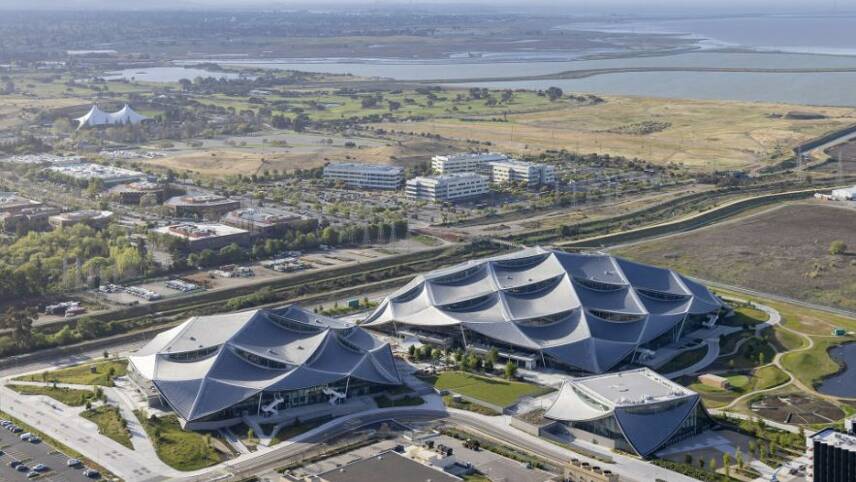Register for free and continue reading
Join our growing army of changemakers and get unlimited access to our premium content

Image: Google
The tech giant’s Bay View and Charleston East campus consists of two office buildings, an events centre, employee accommodation units and 20 acres of open space – 7.3 acres of which have been set aside for nature.
It has been jointly designed by Google and the architecture practices Bjarke Ingels Group and Heatherwick Studio, with this coalition targeting LEED (Leadership in Energy and Environmental Design) ‘Platinum’ certification for the development.
Work first began on the campus site in 2017 and, today (18 May), Google welcomed employees onto the campus for the first time.
None of the campus buildings are connected to gas, meaning that all heating, cooling and cooking processes are electric. 90% of the campus’s electricity demand will be met using solar electricity generated by its rooftop solar array and by local onshore wind farms. The rooftop solar array is ‘dragonscale’ – it consists of overlapping solar panels which ‘are made from prismatic glass. Google claims that the panels, manufactured by SunStyle, maximise generation efficiency as they enable the capture of solar energy from multiple angles.
Also installed on the campus is North America’s largest geothermal pile system. Geothermal piles consist of piled foundations and closed-loop ground-source heat pump systems. They can be installed at shallower depths than geothermal boreholes. The geothermal pile system is connected to a geoexchange field that has been integrated in the structure of the campus buildings, enabling low-carbon heating and cooling.
Google has matched 100% of its global electricity use with renewable electricity purchases each year since 2017. It is now working to increase onsite generation and Power Purchase Agreements (PPAs) to minimise the use of tariffs where possible, as this approach guarantees additionality. Google is also working to launch a digital tool enabling the tracking of renewable electricity generation and consumption in real-time.
Water positivity
The Campus has been delivered using biophilic design principles. Biophilic design refers to design which increases the connection between those who use the building and the natural environment.
Features include ‘direct nature’ – wet meadows, woodland and marsh; indirect nature – artwork depicting local habitats; natural lighting; automated window shades which mimic natural patterns; ventilation systems using 100% outside air and rainwater harvesting systems.
On rainwater harvesting, Google has stated that the Campus will be able to meet its water needs using only the water it collects and recycles on site. The Campus features a series of ponds to collect rainwater as well as its own wastewater treatment system. In fact, the site is targeting ‘water-positivity’ – the water it recycles, combined with the rainwater it collects, should exceed its water consumption. One of the corporate’s overarching sustainability targets is to replenish 120% of the water consumed by its operations by 2030.
Google has applied for the site to achieve the International Living Future Institute’s (ILFI) Living Building Challenge Water Petal Certification.
Developments with Living Building Challenge certifications should be self-sufficient and not extract any additional natural resources like water beyond the resource limits of their bounds. They should also have a positive impact on local people and nature. The Water Petal Certification specifically requires development to “operate within the water balance of their place and climate”.
“Over the years, drought has become ubiquitous across California – but we know that how we choose to build today can have major impacts on access to water for our communities for generations to come,” Google has stated. “For us, the first step was to design a system for Bay View that reduces the buildings’ demand for water in the first place, using integrated water conservation strategies, which in turn ‘right-size’ the amount of water we then need to capture and reuse.”
The first three months of 2022 have been the driest on record for California. The current drought is classed as severe. According to data released by the State this month, absolute water consumption was 3.7% higher in April 2022 than in July 2020. The State is, therefore, planning a major communication campaign encouraging businesses and households to reduce their water use.


Please login or Register to leave a comment.